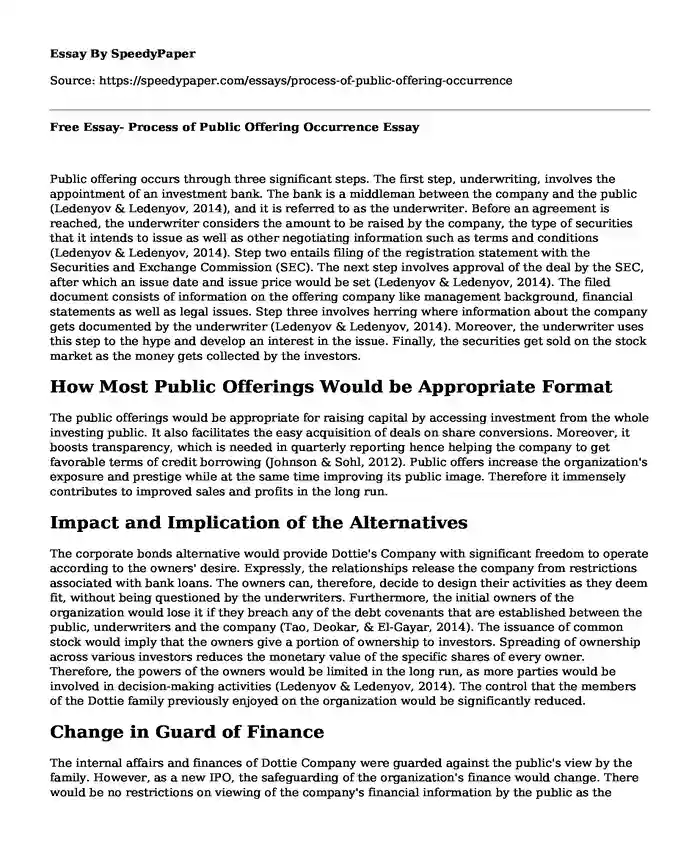
| Type of paper: | Case study |
| Categories: | Banking Sales Business plan |
| Pages: | 3 |
| Wordcount: | 729 words |
Public offering occurs through three significant steps. The first step, underwriting, involves the appointment of an investment bank. The bank is a middleman between the company and the public (Ledenyov & Ledenyov, 2014), and it is referred to as the underwriter. Before an agreement is reached, the underwriter considers the amount to be raised by the company, the type of securities that it intends to issue as well as other negotiating information such as terms and conditions (Ledenyov & Ledenyov, 2014). Step two entails filing of the registration statement with the Securities and Exchange Commission (SEC). The next step involves approval of the deal by the SEC, after which an issue date and issue price would be set (Ledenyov & Ledenyov, 2014). The filed document consists of information on the offering company like management background, financial statements as well as legal issues. Step three involves herring where information about the company gets documented by the underwriter (Ledenyov & Ledenyov, 2014). Moreover, the underwriter uses this step to the hype and develop an interest in the issue. Finally, the securities get sold on the stock market as the money gets collected by the investors.
How Most Public Offerings Would be Appropriate Format
The public offerings would be appropriate for raising capital by accessing investment from the whole investing public. It also facilitates the easy acquisition of deals on share conversions. Moreover, it boosts transparency, which is needed in quarterly reporting hence helping the company to get favorable terms of credit borrowing (Johnson & Sohl, 2012). Public offers increase the organization's exposure and prestige while at the same time improving its public image. Therefore it immensely contributes to improved sales and profits in the long run.
Impact and Implication of the Alternatives
The corporate bonds alternative would provide Dottie's Company with significant freedom to operate according to the owners' desire. Expressly, the relationships release the company from restrictions associated with bank loans. The owners can, therefore, decide to design their activities as they deem fit, without being questioned by the underwriters. Furthermore, the initial owners of the organization would lose it if they breach any of the debt covenants that are established between the public, underwriters and the company (Tao, Deokar, & El-Gayar, 2014). The issuance of common stock would imply that the owners give a portion of ownership to investors. Spreading of ownership across various investors reduces the monetary value of the specific shares of every owner. Therefore, the powers of the owners would be limited in the long run, as more parties would be involved in decision-making activities (Ledenyov & Ledenyov, 2014). The control that the members of the Dottie family previously enjoyed on the organization would be significantly reduced.
Change in Guard of Finance
The internal affairs and finances of Dottie Company were guarded against the public's view by the family. However, as a new IPO, the safeguarding of the organization's finance would change. There would be no restrictions on viewing of the company's financial information by the public as the organization would be in a binding contract by the same public following sale of corporate bonds (Marinkovic, Ljumovic & Stojkovic, 2012). The financial reporting effects of this decision is that the organization would be compelled to reveal its actual financial position to the public periodically and make the information accessible at all times to interested members of the public. Any additional debt incurred or acquired by the organization would reduce the future earnings of the shareholders (Tao, Deokar, & El-Gayar, 2014). Also, new stockholders would change the management of the company by reducing the powers of the previously existing owners. Moreover, the original stockholders would be involved in the decision-making process. Therefore, there would be an overall loss of control of the company by the family members who previously owned it.
References
Johnson, W. C., & Sohl, J. (2012). Angels and venture capitalists in the initial public offering market. Venture Capital, 14(1), 27-42.
Ledenyov, D., & Ledenyov, V. (2014). Strategies on initial public offering of company equity at stock exchanges in imperfect highly volatile global capital markets with induced nonlinearities. Available at SSRN 2577767.
Marinkovic, S., Ljumovic, I., & Stojkovic, D. (2012). Going public and initial public offering: An exploratory study of motives from Serbian companies. Industrija, 40(2), 125-143.
Tao, J., Deokar, A. V., & El-Gayar, O. F. (2014). An ontology-based information extraction (OBIE) framework for analyzing initial public offering (IPO) prospectus. In 2014 47th Hawaii International Conference on System Sciences (pp. 769-778). IEEE.
Cite this page
Free Essay- Process of Public Offering Occurrence. (2023, Mar 22). Retrieved from https://speedypaper.com/essays/process-of-public-offering-occurrence
Request Removal
If you are the original author of this essay and no longer wish to have it published on the SpeedyPaper website, please click below to request its removal:
- Social Activities Essay Sample
- Free Essay with Organisational Communication Research
- Essay Sample on Visual Merchandising and Display Techniques
- Saudi Arabia Case Study Example
- The Law of Failure Is Misleading - Essay Example in Strategic Marketing
- "Reflection on the End of Racial Representation" Chapter Discussion Essay Sample
- Essay Example Describing the Forms of Bad Statistics
Popular categories




